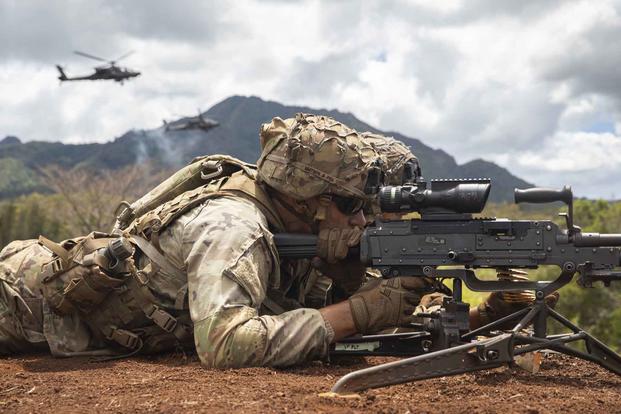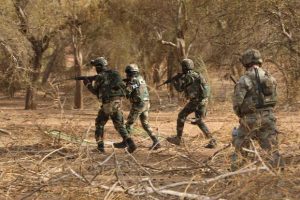The Army is seeking to better prepare itself for a potential conflict in the Pacific, with increased spending on regional training, deployments and equipment, according to its fiscal 2025 budget request.
The service has requested a 200% increase in funding for Pacific training and employment, in addition to a massive $1.5 billion chunk of funding for its branch of the Pacific Deterrence Initiative, or PDI, the Defense Department’s plan for ensuring relative peace in the region, according to budget documents.
“From the Obama administration to the Trump administration to the Biden administration, it’s been pretty consistent support for this region being the most consequential region, at the most consequential time, against the most consequential adversary,” Gen. Charles Flynn, commander of U.S. Army Pacific, told students at the Army War College in January.
Read Next: Supply or Die: Sustaining Marines in the High North so They Can Fight and Win a Future War
“I think a broad recognition that what this threat represents is, and could be, existential to our way of life and of freedom-loving people,” Flynn said.
For fiscal 2024, the Defense Department, as a whole, put $9 billion into the PDI. Additional funds were allocated and spent for operations within the Indo-Pacific region, external to the PDI umbrella.
The $464 million requested for training and employment will account for about 40 Pacific Pathways exercises, which are conducted by U.S. Army Pacific and deploy troops and material to support security cooperation exercises with partner militaries, including Thailand and the Philippines.
Gabe Camarillo, the under secretary of the Army, told reporters at a budget roundtable last week that he believed this was the most money the Army has ever requested, if not just over the last few years, for training in the Pacific.
“As I always say, all of those nations in the Pacific, they all have armies, and
they appreciate the opportunity to train with us, to do joint exercises,” Camarillo said. “And so, we have endeavored to fund those exercises to the fullest extent we can.”
While specifics were not included in the budget documents, the Army highlighted the rotational deployments it plans to conduct in the region in 2025.
“We are sustaining a career rotation, and that is not a [temporary duty station]; that is a rotational force,” Maj. Gen. Chuck Lombardo, the head of Army training, told Military.com on Tuesday. “Stryker Brigade supported the 2nd Infantry Division, and that is continuing in ’25. [There will be] a heavy, heavy increase in the Pacific campaigning.”
The Army has proven that it’s already started tailoring its training to match a potential physical conflict in the Pacific, with soldiers from the U.S. Army Special Operations Command participating in its annual capabilities exercise, or CAPEX.
During one of the training missions — which usually focus on the tactics and weapons favored during the Global War on Terror — Special Forces troops were tasked with completing a mock insertion into Taiwan to defend against a potential Chinese invasion.
“The [People’s Republic of China], in accordance with our national defense strategy, is our true pacing challenge out there,” Lt. Gen. Jonathan Braga, commanding general of Army Special Operations Command, said in a speech ahead of the exercise. “Ultimately, what we are trying to do is prevent World War III. That’s our job.”
Increasingly over the last few years, China has upped the ante in the region, with consistent reports of Chinese drones circling the island of Taiwan and following U.S. ships as they routinely navigate through the Taiwan Strait.
And as a whole, the U.S. military has shifted its priorities to meet the challenge, and it has not flinched away from naming China as its adversary.
The Air and Space Forces even announced in February they would be making some of the most sweeping changes in their history by renaming, reorganizing and rethinking their services’ structures so troops can better prepare themselves for competition with China.
The changes included bringing back warrant officers — a plan first reported by Military.com — as well as changes to training. It was all necessary as China prepares for war in the Pacific and, potentially, against the U.S. military, Air Force Secretary Frank Kendall said at the Air and Space Forces Association’s Warfare Symposium conference in February, following the announcement.
“We are out of time,” Kendall said. “Why do I say that? It’s not that I enjoy sounding like a broken record. It’s because, for at least two decades, China has been building a military that is designed, purpose-built, to deter and defeat the United States if we intervene in the western Pacific.”
Meanwhile, additional requests for funding by the Army included more than $1 billion to better arm units with missile defense systems and munitions — with more than $600 million going toward the defense of Guam, home to U.S. troops and bases — and $86 million for watercraft procurement, about which the Army did not respond to Military.com’s request for further comment.
— Rachel Nostrant is a Marine Corps veteran and freelance journalist, with work published in Reuters, New York Magazine, Military Times and more.
Story Continues
Please rate this CIBA article
Vote






